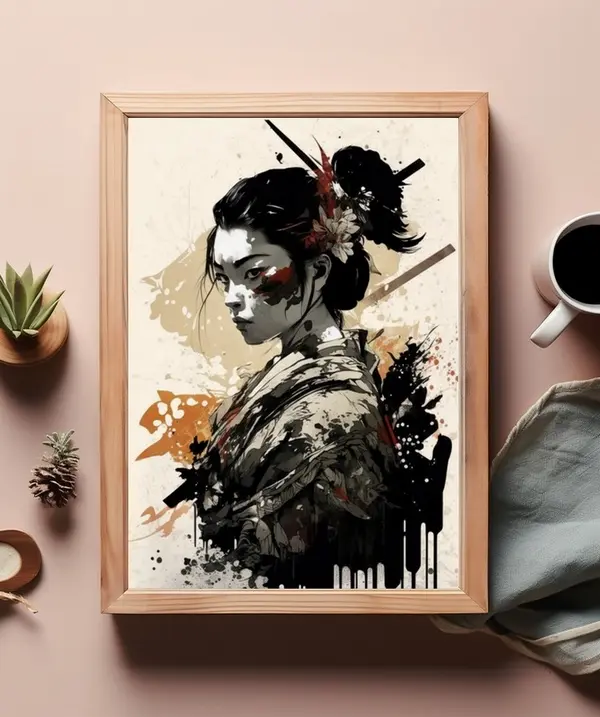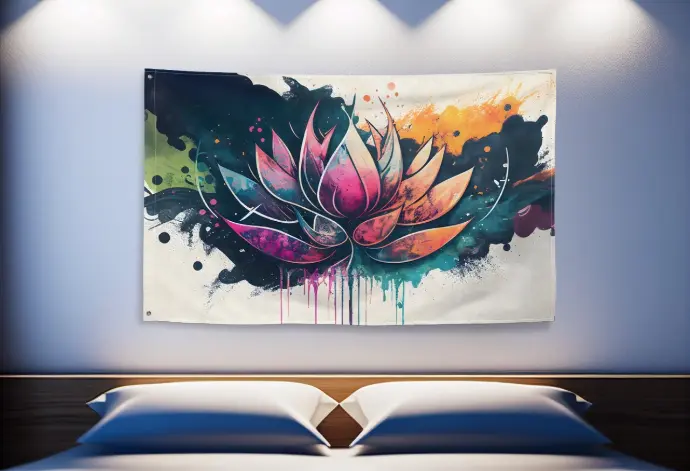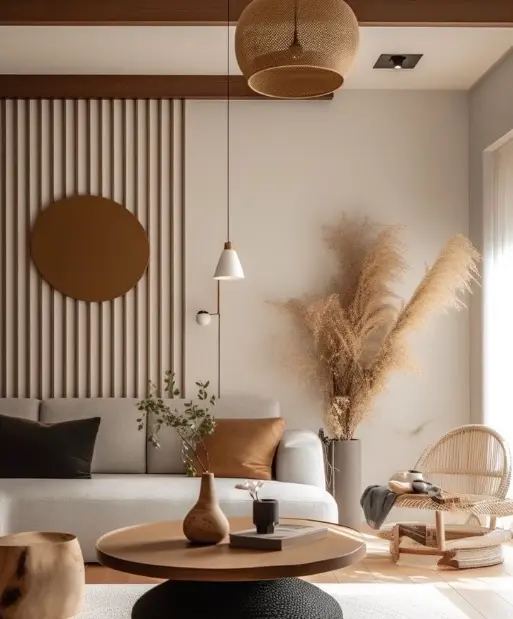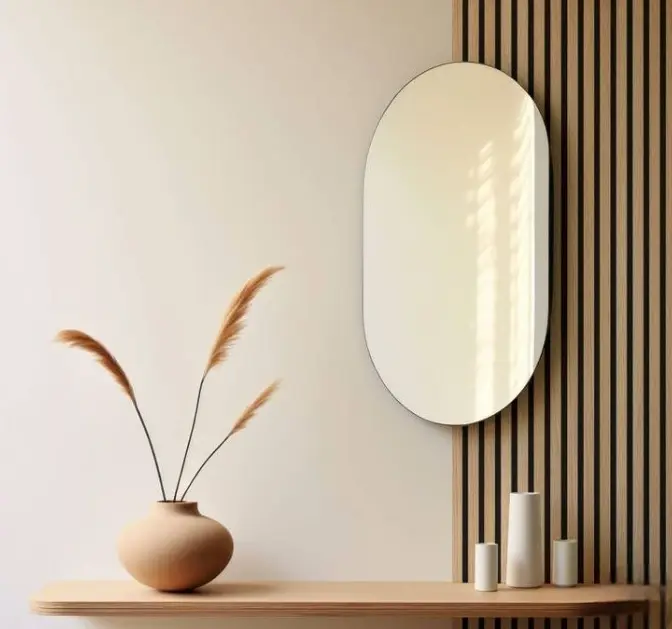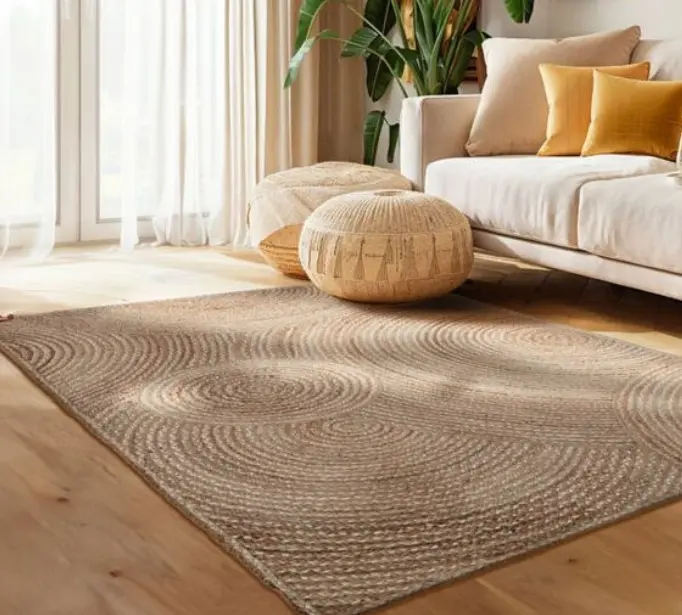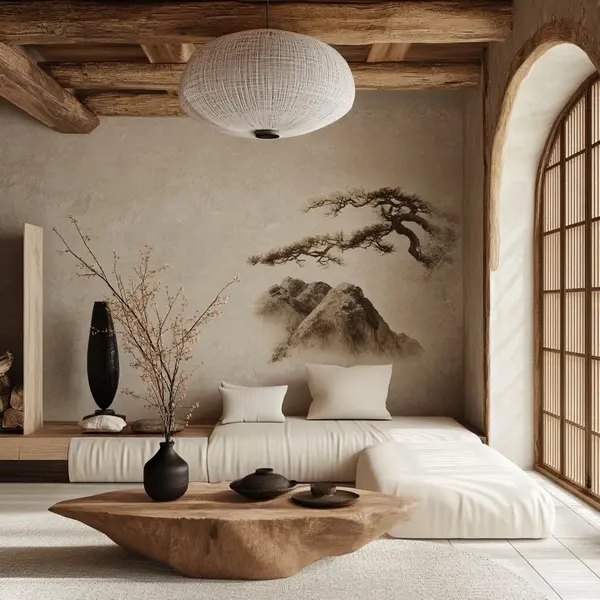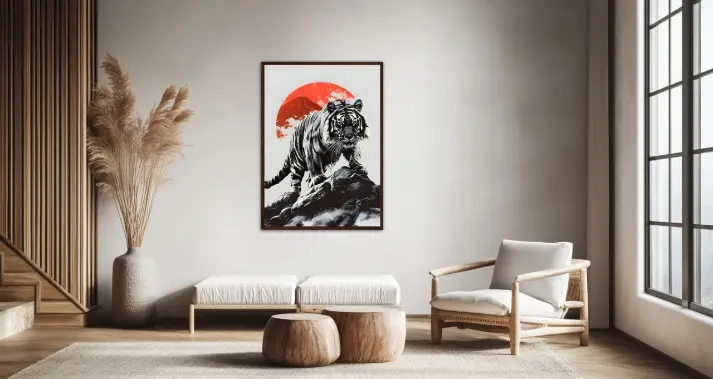Publié le 27 janvier 2025 - édité le 09 Février 2025
I found an old lamp at a garage sale, and guess what? No genius to tell me about Bitcoin (damn, it could have been practical), but a decorative concept that will brighten up your interior: the Japandi style! It's a bit like two cultures meeting in a bar, and the connection immediately passes. One, all sobriety and imperfections, the other, warm and functional. The result? An interior where you want to relax with a good book and a cup of tea (or a glass of wine, we don't judge 😜).
Are you wondering what is behind this strange word, “Japandi”? So, follow the guide, and let's discover together the codes of this style which has everything to seduce you.
What is japandi style?
Origin of the Japandi style:
The Japandi style was born from this unexpected encounter, combining Japanese minimalist elegance with Scandinavian cocooning.
So what happens when these two worlds collide? Well, they make sparks (oh oh, slowly, I know very well what you were thinking 😳)! The Japandi style was born from this fusion and the Japanese philosophy of wabi-sabi, creating an interior that is both refined and warm, minimalist and comfortable. It’s a response to a world where everything moves too fast, an invitation to slow down, to refocus on the essentials, and to adopt a zen interior decoration.
The term "Japandi" is simply the combination of the words "Japan" and "Scandinavia".
Some Asian and Japandi decoration ideas:
A living room with a Zen atmosphere with wooden furniture and terracotta pots, all complemented by a wall hanging with an Asian and Zen (Hindu) spirit. (click on the image for more information on the hanging)
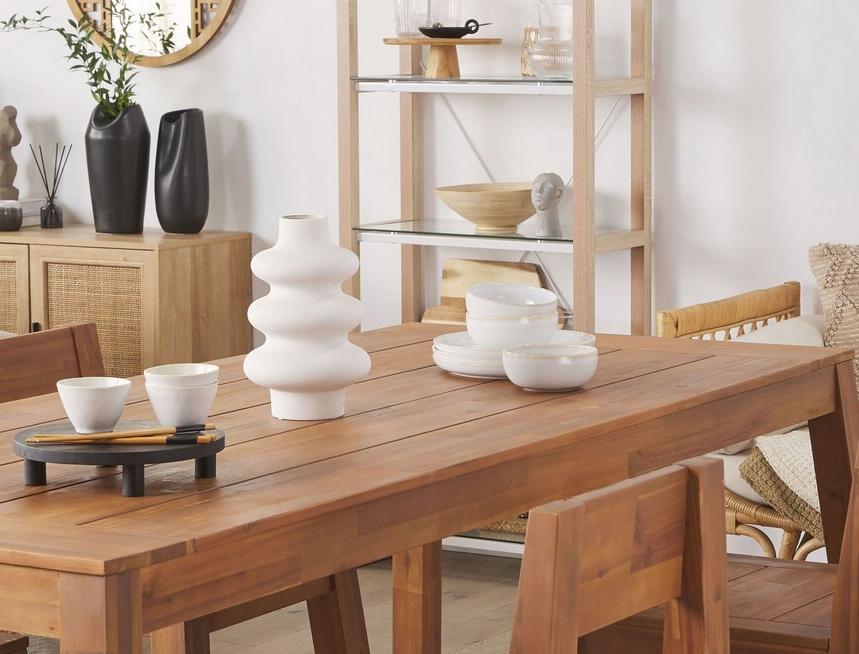 Wooden table and chairs, image from the Beliani.fr website : www.beliani.fr
Wooden table and chairs, image from the Beliani.fr website : www.beliani.fr
What are the main characteristics of japandi decoration?
• Colors :
Japandi is the art of the happy medium, so we immediately forget the garish colors that sting the eyes! The color palette is neutral and soft, inspired by nature, it's a real star when it comes to choosing colors for the Japandi style. We're talking about natural shades, like sandstone, taupe, or even earthy brown, as if we had borrowed the colors from a walk in the forest. The idea is to bring nature into your home. (without bringing back all the critters that go with it)
Here is a moodboard to illustrate my point and the key elements :
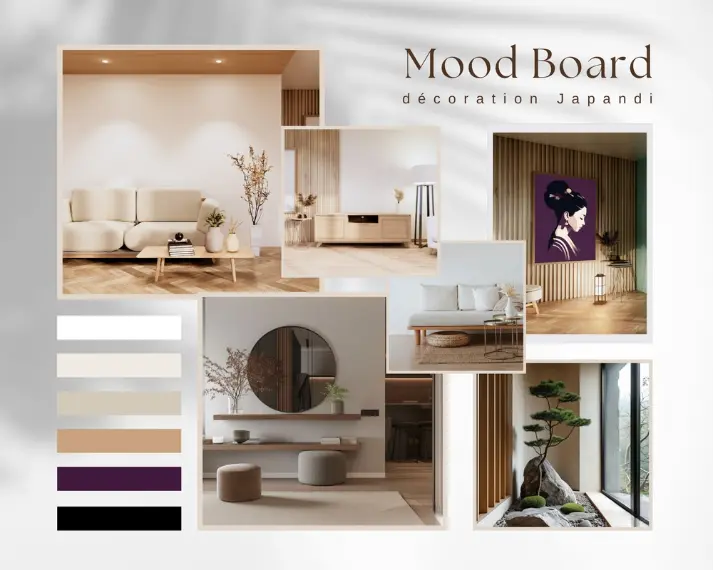
• Shapes, furniturs & materials :
Low is the base (no pun intended, but in french.. 😂): In Japandi, furniture is often low and discreet to get closer to the earth and find a little simplicity in our daily lives. We forget about furniture that casts shadows and we adopt simple lines and soft shapes. We like irregular finishes, authentic textures, which bring a touch of charm and character, this is the idea of "wabi-sabi", which celebrates beauty in imperfection. Also, we don't hesitate to let the sun in to create a warm atmosphere; natural light is a real ally.
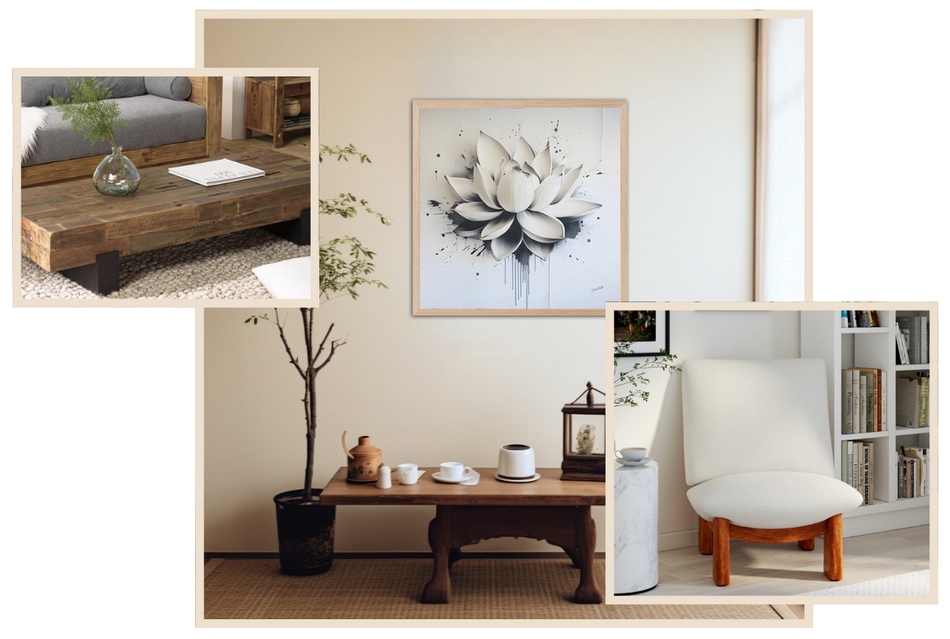
Plastic is fantastic (french publicity song) 🎶 for your children's toys, but not for Japandi decor! Here, the star material is wood! We love it in all its forms, clear, warm and natural. We find it in furniture, shelves, and even on the walls (with battens, it's classy). You can opt for oak, walnut, bamboo or rattan, in short, anything that reminds us of nature.
We are looking for open storage where we can display some decorative objects from crafts, stoneware vases, or even travel souvenirs. The idea is to mix business with pleasure, to ensure that our storage is both practical and aesthetic.
• Decoration and japandi plants:
Japanese design is not a race for accumulation, but rather a celebration of “less is more”. You must select your decorative accessories carefully. We don't fill the space with superfluous objects, but with a few functional and aesthetic pieces that have a story to tell. Each object is there for a reason, to create a soothing atmosphere: terracotta, raw stoneware or ceramic vases, scented candles. rice paper or bamboo lanterns, linen seats and woven natural fiber rugs.
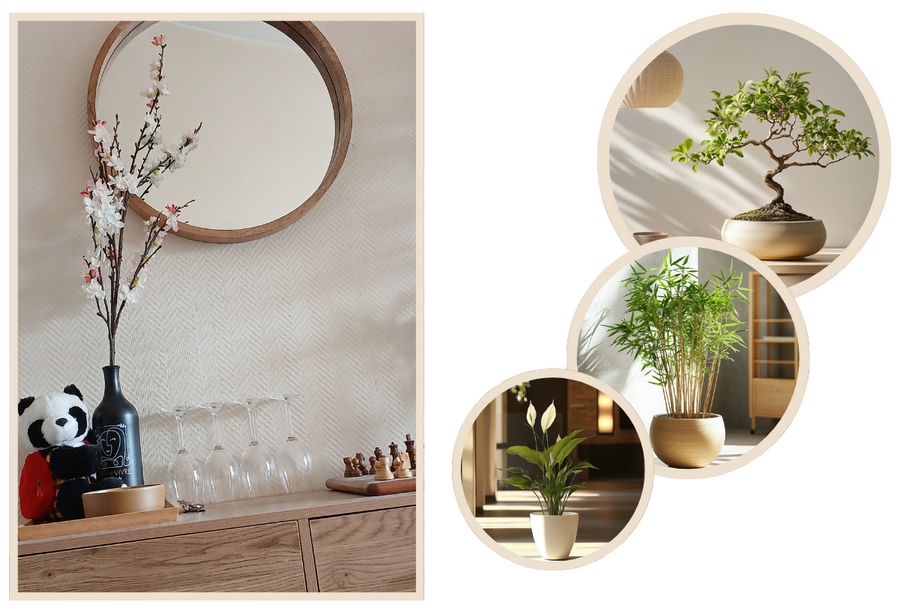
What about plants then? They are much more than just decorative accessories! They are like extras in a film, essential to the atmosphere: bamboo for the Zen side, peace lilies for serenity (and because they are easy to live with), or even sansevierias, for their look aesthetic. You can also add cherry tree branches for the poetic side, and bonsai for the Japanese side. We arrange everything with elegance and simplicity, avoiding the "jungle" effect. The idea is to create harmony between the vegetation and the rest of the decoration. And cherry on the cake, these japandi plants are easy to maintain and fit well inside. 🥰
Conclusion: Less mess, more zen
What future for the Japandi and Zen trend?
Japandi and wabi-sabi are described as emerging trends that are "invading our interiors" and are increasingly present in decoration magazines and presented as a major trend for 2025. Coming from two popular and enduring styles, Japanese design and Scandinavian style. We're not going to put japandi in the closet just yet!
The link with the 4 seasons method.
Japandi is usually found in the “winter” and “summer” seasons and sometimes even for spring. It’s a decor trend that likes natural materials like wood. The atmosphere will combine soft, subtle and light shades reminding us of the “summer” season with airy or even minimalist spaces for “winter” elements. We don't forget the mix between Japan and Scandinavia, also appreciated during the "spring" season. In short, there is something for everyone with this decorative trend (or almost, sorry for the autumn people 😜). The result? A bright and comfortable house, a true haven of peace.
Now that you have all the cards in hand, it's time to take action! Japandi is not reserved for decoration experts, it is a style accessible to everyone. So, we tidy up, we sort, we give, we sell, we throw away (in moderation, we are not savages). Who knows, maybe while tidying up you'll find an old magic lamp (but it's about Japandi this time)! We make room for beauty, functionality, and above all for zen. We choose soft colors, natural materials, simple furniture, Asian wall decoration and a few plants to bring nature into your home. We don't forget the warm lighting. and ventilated spaces. In short, the most important thing is to feel good at home. And if you ever get lost, don’t hesitate to reread this article, it’s there to guide you! 😉
If you like the article and you would like to be informed of our next publications, you can register on our site, or follow us:
Follow us
Thank's for reading to the end!
share :
Summary :
• What is japandi style?
Origin of the Japandi style:
Some Asian and Japandi decoration ideas.
• What are the main characteristics of japandi decoration?
Colors.
Shapes, furniture, materials & materials.
Decoration and japandi plants.
• Conclusion: Less mess, more zen.
What future for the Japandi and Zen trend?
The link with the 4 seasons method.
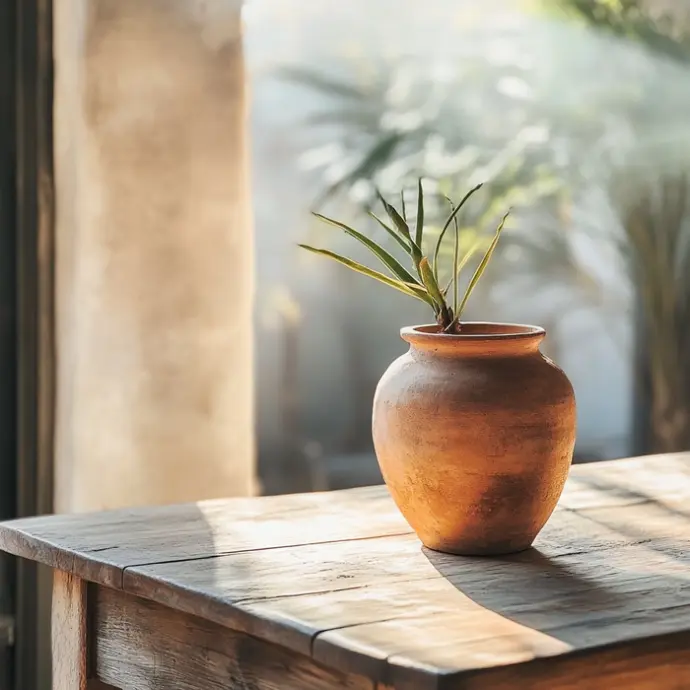

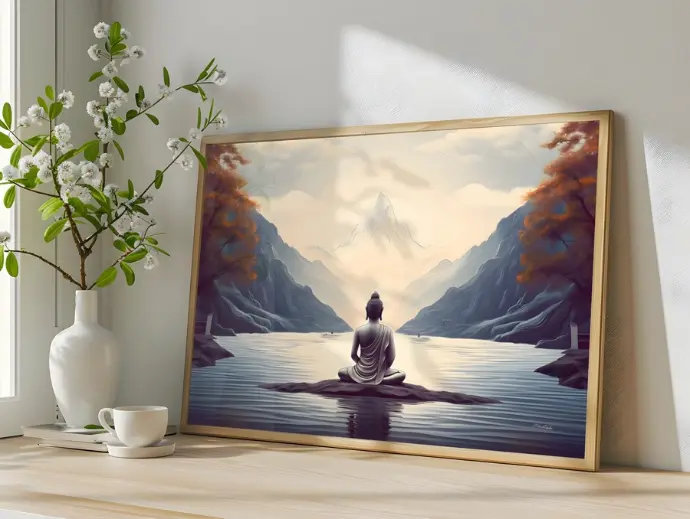
Japandi poster print :
